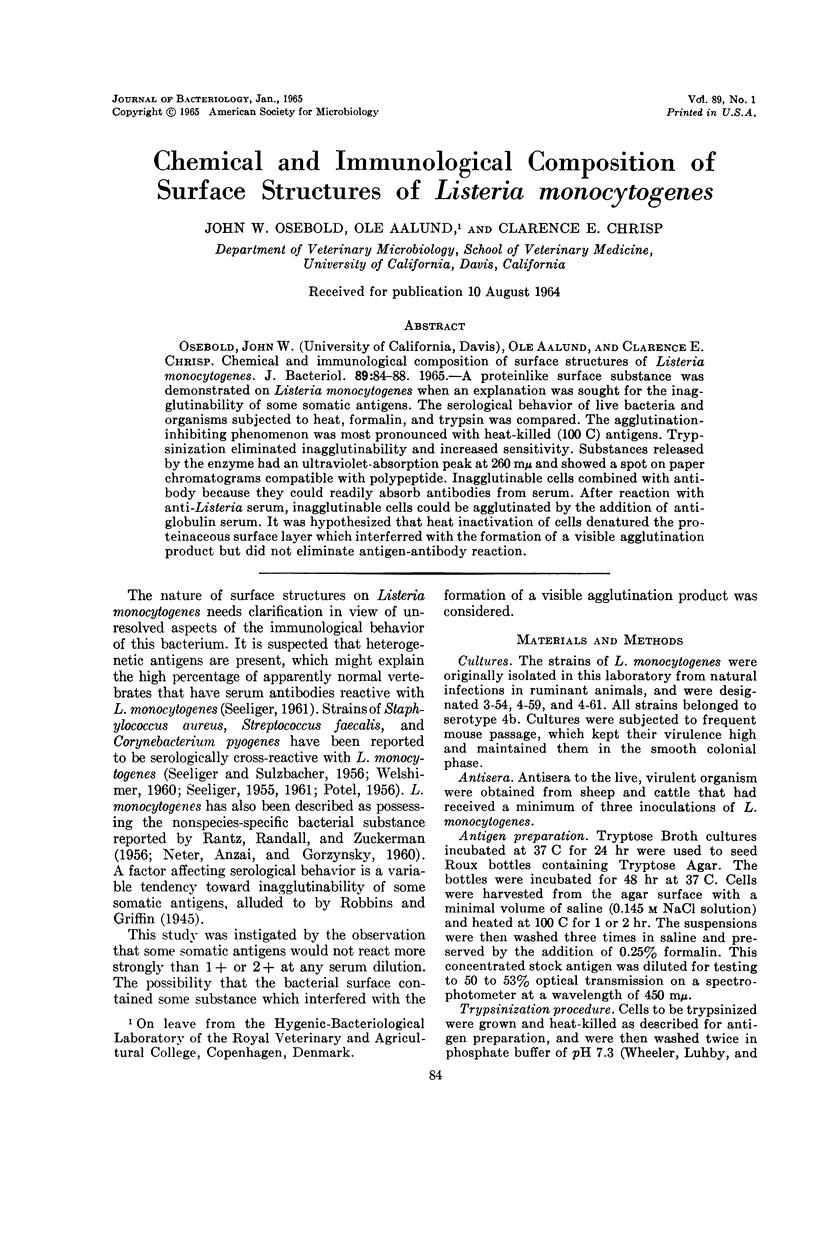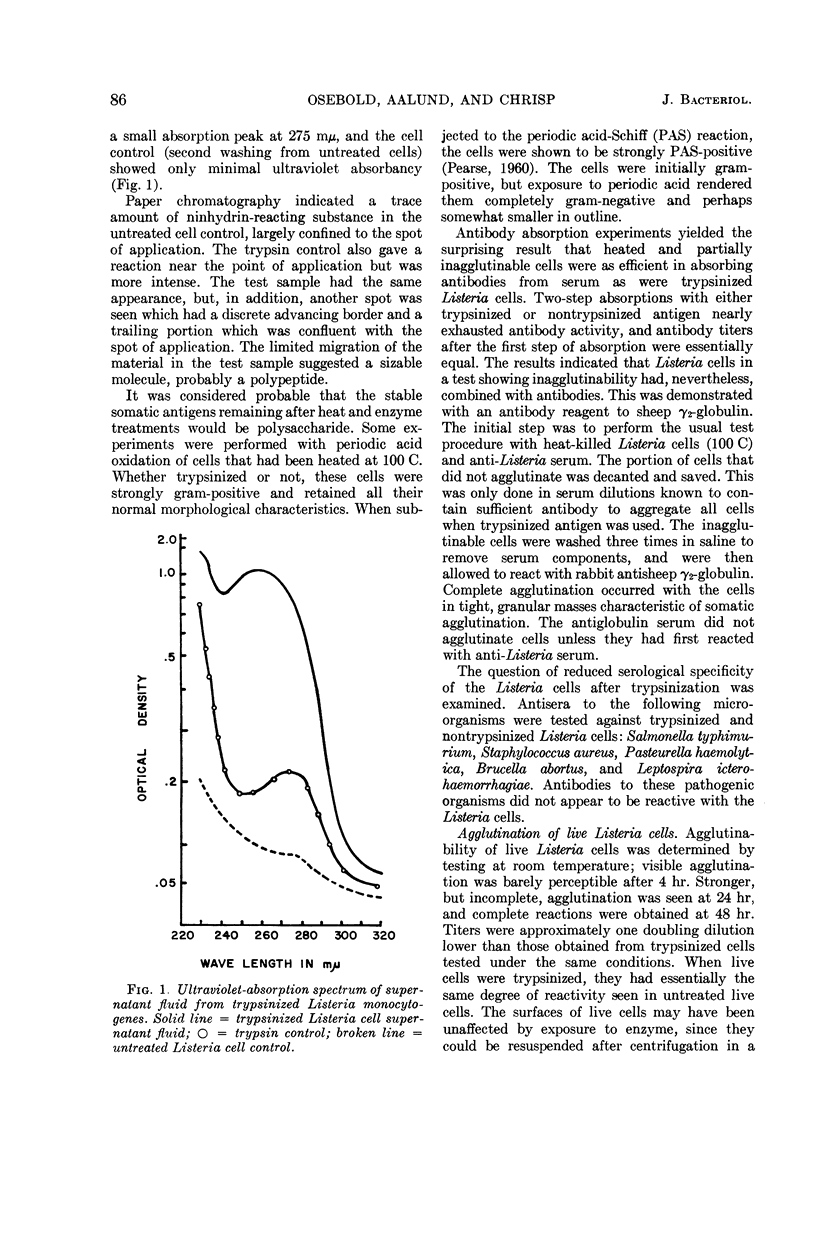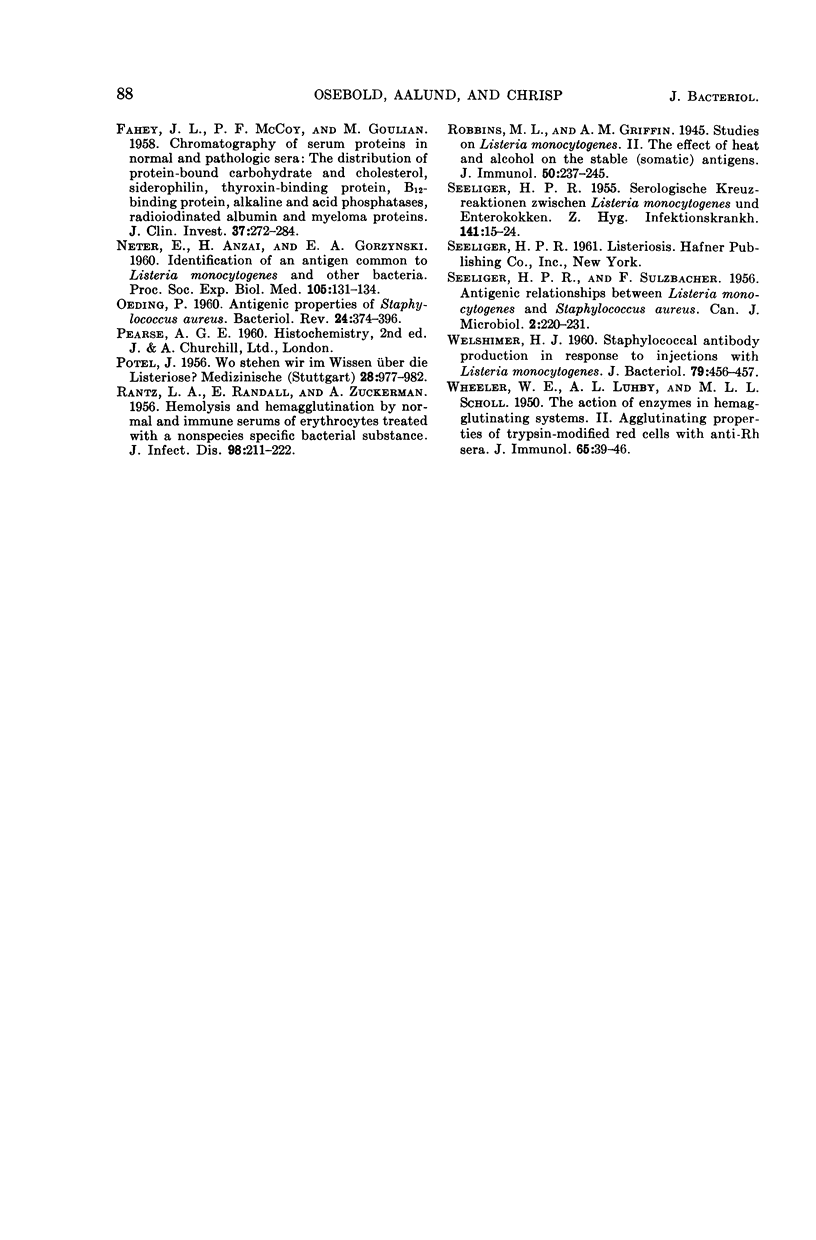Abstract
Osebold, John W. (University of California, Davis), Ole Aalund, and Clarence E. Chrisp. Chemical and immunological composition of surface structures of Listeria monocytogenes. J. Bacteriol. 89:84–88. 1965.—A proteinlike surface substance was demonstrated on Listeria monocytogenes when an explanation was sought for the inagglutinability of some somatic antigens. The serological behavior of live bacteria and organisms subjected to heat, formalin, and trypsin was compared. The agglutination-inhibiting phenomenon was most pronounced with heat-killed (100 C) antigens. Trypsinization eliminated inagglutinability and increased sensitivity. Substances released by the enzyme had an ultraviolet-absorption peak at 260 mμ and showed a spot on paper chromatograms compatible with polypeptide. Inagglutinable cells combined with antibody because they could readily absorb antibodies from serum. After reaction with anti-Listeria serum, inagglutinable cells could be agglutinated by the addition of antiglobulin serum. It was hypothesized that heat inactivation of cells denatured the proteinaceous surface layer which interferred with the formation of a visible agglutination product but did not eliminate antigen-antibody reaction.
Full text
PDF




Selected References
These references are in PubMed. This may not be the complete list of references from this article.
- BARKULIS S. S., JONES M. F. Studies of streptococcal cell walls. I. Isolation, chemical composition, and preparation of M protein. J Bacteriol. 1957 Aug;74(2):207–216. doi: 10.1128/jb.74.2.207-216.1957. [DOI] [PMC free article] [PubMed] [Google Scholar]
- CUMMINS C. S. Some observations on the nature of the antigens in the cell wall of Corynebacterium diphtheriae. Br J Exp Pathol. 1954 Apr;35(2):166–180. [PMC free article] [PubMed] [Google Scholar]
- EDWARDS M. R., STEVENS R. W. FINE STRUCTURE OF LISTERIA MONOCYTOGENES. J Bacteriol. 1963 Sep;86:414–428. doi: 10.1128/jb.86.3.414-428.1963. [DOI] [PMC free article] [PubMed] [Google Scholar]
- FAHEY J. L., McCOY P. F., GOULIAN M. Chromatography of serum proteins in normal and pathologic sera: the distribution of protein-bound carbohydrate and cholesterol, siderophilin, thyroxin-binding protein, B12-binding protein, alkaline and acid phosphatases, radio-iodinated albumin and myeloma proteins. J Clin Invest. 1958 Feb;37(2):272–284. doi: 10.1172/JCI103606. [DOI] [PMC free article] [PubMed] [Google Scholar]
- OEDING P. Antigenic properties of Staphylococcus aureus. Bacteriol Rev. 1960 Dec;24(4):374–396. doi: 10.1128/br.24.4.374-396.1960. [DOI] [PMC free article] [PubMed] [Google Scholar]
- POTEL J. Wo stehen wir im Wissen über die Listeriose? Medizinische. 1956 Jul 14;7(27-28):977–982. [PubMed] [Google Scholar]
- RANTZ L. A., RANDALL E., ZUCKERMAN A. Hemolysis and hemagglutination by normal and immune serums of erythrocytes treated with a nonspecies specific bacterial substance. J Infect Dis. 1956 Mar-Apr;98(2):211–222. doi: 10.1093/infdis/98.2.211. [DOI] [PubMed] [Google Scholar]
- SEELIGER H. P., SULZBACHER F. Antigenic relationships between Listeria monocytogenes and Staphylococcus aureus. Can J Microbiol. 1956 May;2(3):220–231. doi: 10.1139/m56-027. [DOI] [PubMed] [Google Scholar]
- SEELIGER H. Serologische Kreuzreaktionen zwischen Listeria monocytogenes und Enterokokken. Z Hyg Infektionskr. 1955;141(1):15–24. [PubMed] [Google Scholar]
- WELSHIMER H. J. Staphylococcal antibody production in response to injections with Listeria monocytogenes. J Bacteriol. 1960 Mar;79:456–457. doi: 10.1128/jb.79.3.456-457.1960. [DOI] [PMC free article] [PubMed] [Google Scholar]
- WHEELER W. E., LUHBY A. L., SCHOLL M. L. L. The action of enzymes in hemagglutinating systems. II. Agglutinating properties of trypsin-modified red cells with anti-Rh sera. J Immunol. 1950 Jul;65(1):39–46. [PubMed] [Google Scholar]


